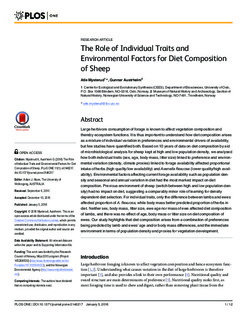| dc.description.abstract | Large herbivore consumption of forage is known to affect vegetation composition and
thereby ecosystem functions. It is thus important to understand how diet composition arises
as a mixture of individual variation in preferences and environmental drivers of availability,
but few studies have quantified both. Based on 10 years of data on diet composition by aid
of microhistological analysis for sheep kept at high and low population density, we analysed
how both individual traits (sex, age, body mass, litter size) linked to preference and environmental variation (density, climate proxies) linked to forage availability affected proportional
intake of herbs (high quality/low availability) and Avenella flexuosa(lower quality/high availability). Environmental factors affecting current forage availability such as population density and seasonal and annual variation in diet had the most marked impact on diet
composition. Previous environment of sheep (switch between high and low population density) had no impact on diet, suggesting a comparably minor role of learning for density
dependent diet selection. For individual traits, only the difference between lambs and ewes
affected proportion ofA.flexuosa, while body mass better predicted proportion of herbs in
diet. Neither sex, body mass, litter size, ewe age nor mass of ewe affected diet composition
of lambs, and there was no effect of age, body mass or litter size on diet composition of
ewes. Our study highlights that diet composition arises from a combination of preferences
being predicted by lamb and ewes’ age and/or body mass differences, and the immediate
environment in terms of population density and proxies for vegetation development. | nb_NO |
